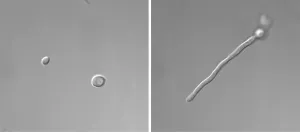New, almost non-destructive archaeogenetic sampling method developed
A new method that allows the almost non-destructive extraction of genetic material from archaeological human remains
2021-05-05
(Press-News.org) An Austrian-American research team (University of Vienna, Department Evolutionary Anthropology and Harvard Medical School, Department of Genetics), in collaboration of Hungarian experts from Eötvös Loránd University, has developed a new method that allows the almost non-destructive extraction of genetic material from archaeological human remains. The method allows anthropologists, archaeologists and archaeogeneticists to avoid the risk of serious damage to artefacts of significant scientific and heritage value, which can then be fully examined in future research.
Bioarcheological research on human and animal remains from archaeological excavations has become increasingly important in recent decades. Both nationally and internationally, in addition to classical archaeological and anthropological research, a significant number of molecular biological way of examination are included. One of the most important fields is archaeogenetics. The study of ancient human and animal genetic material can significantly help both the analysis of human evolution and the answering of historical questions about the populations of later archaeological periods.
The first archaic DNA (aDNA) research started in the 1980s, but the real methodological breakthroughs came after the turn of the millennium. This was the period when next-generation sequencing methods reached bioarcheological research. Thanks to the large-scale research that began at that time, we now know more than 60% of the DNA of Neanderthals preserved in the nuclei of cells. A new human species was described on the basis of the genetic material extracted from teeth and finger bones found in Siberia, and it was recognised that, contrary to previous ideas, Neanderthal man and modern Homo sapiens interbred with each other, that left significant genetic traces in modern human groups north of the Sahara.
However, these samples for archaeogenetic analyses may involve a high degree of destruction and may therefore be of concern from a heritage conservation perspective, preventing or making it difficult to obtain and carry out the sampling.
An international team of researchers (Ron Pinhasi laboratory at the University of Vienna and David Reich' laboratory at Harvard) has recognised this problem and has recently developed several new sampling methods to minimise the bone damage associated with sampling. Firstly, the methodological basis for drilling into the inner ear from the cranial base was developed and later it was shown that the use of auditory ossicles can significantly reduce the damage in the fining during sampling.
The latest research, published in the journal Genome Research, was carried out by the above-mentioned international team and the researchers of the Department of Anthropology (Tamás Hajdu, Krisztián Kiss, Tamás Szeniczey) and the Institute of Archaeology (Alexandra Anders, Pál Raczky) at Eötvös Loránd University.
„The new method significantly reduces the extent of damage of the findings. It consists of dissolving the DNA content of the root fragment of the tooth, rich in cellular cementum, by immersing it in a special solution. The quality of the sample thus obtained is not as good as that of DNA extracted from the inner ear, but it is of the same quality as that of the genetic material obtained by traditional methods (drilling and pulverisation of the tooth). The main advantage of the method is that the tooth undergoes only to minimal damage, leaving its structure intact not only morphologically but also histologically, while its unchanged chemical composition allows subsequent isotopic tests (strontium or C14) to be carried out. The only noticeable change is the fading or whitening of the root colour" - told Tamas Hajdu, head of the Hungarian research group, Assistant Professor at the Department of Anthropology at Eötvös Loránd University.
The significance of the new sampling method, therefore, lies in its minimal destructive effect. If the sampled teeth are left intact, they can be subjected to further morphological, radiological, histological, oral pathological, stable isotope and radiocarbon studies. This may be particularly important in cases where only a few teeth remain have been preserved from a given period and place, which may be tens of thousands of years old, and destructive sampling of these would completely preclude subsequent analysis. In addition to human evolutionary research, the new methodology could also help projects on population history and disease evolution at the Department of Anthropology and the Institute of Archaeology, at Eötvös Loránd University by preserving the integrity of the findings. The new sampling method, developed in international cooperation, offers a new perspective for the preservation of artefacts for national and international museum institutions, while at the same time allowing for the almost non-destructive conduct of the latest archaeogenetic analyses.
ENDING:
The international team of researchers has developed a new sampling method and tested its effectiveness on human material from several archaeological sites in Hungary and abroad. The Hungarian archaeological material can be found in the collections of the Hungarian Natural History Museum, the Herman Ottó Museum, the Déri Museum and the Damjanich János Museum. The new method was initiated by Ron Pinhasi' research group at the Department of Evolutionary Anthropology, the University of Vienna and the methodological background was worked out, and the bone and tooth samples were analysed, and the Austrian team and David Reich' Laboratory at the Department of Genetics, Harvard Medical School. The anthropological background of the findings was provided by the Department of Anthropology at Eötvös Loránd University and Department of Anthropology at the Hungarian Natural History Museum and the Institute of Archaeology, ELKH-BTK (Tamás Hajdu, Tamás Szeniczey, Krisztián Kiss, Ildikó Pap, Kitti Köhler). The basic archaeological background data of the research (archaeological age, cultural classification, archaeological context of the finds) were provided by the joint work of the research staff of several Hungarian institutions (ELTE BTK Archaeological Institute: Alexandra Anders, Pál Raczky; Déri Museum: János Dani, Barbara Kolozsi, Emese Gyöngyvér Nagy; Herman Otto Museum: B. Hellebrandt Magdolna, Horváth Antónia; ELKH BTK Archaeology Institute: Király Ágnes; Damjanich János Museum: Kovács Péter; Ásatárs Kft.)
INFORMATION:
[Attachments] See images for this press release:

ELSE PRESS RELEASES FROM THIS DATE:
2021-05-05
The first mental health study of Black communities in Canada has found the majority of Black Canadians display severe depressive symptoms - women, even more so - with racial discrimination confirming the appearance of these signs for nearly all.
The study, published in Depression and Anxiety, discovered nearly two-thirds (65.87 percent) of surveyed participants reported severe depressive symptoms. Higher rates were found among women; those who are employed; those born in Canada; and nearly all who have been experienced high racial discrimination.
"Rates of depressive symptoms among Black individuals are nearly six times the 12-month prevalence reported for the general population in Canada," says ...
2021-05-05
Granular materials, such as sand and gravel, are an interesting class of materials. They can display solid, liquid, and gas-like properties, depending on the scenario. But things can get complicated in cases of high-speed vehicle locomotion, which cause these materials to enter a "triple-phase" nature, acting like all three fundamental phases of matter at the same time.
As reported in the April 23, 2021 issue of the journal Science Advances, a team of engineers and physicists from the Massachusetts Institute of Technology (MIT) and Georgia Institute ...
2021-05-05
The field of photonics aims to transform all manner of electronic devices by storing and transmitting information in the form of light, rather than electricity. Beyond light's raw speed, the way that information can be layered in its various physical properties makes devices like photonic computers and communication systems tantalizing prospects.
Before such devices can go from theory to reality, however, engineers must find ways of making their light sources -- lasers -- smaller, stronger and more stable. Robots and autonomous vehicles that use LiDAR for optical sensing and ranging, manufacturing and material ...
2021-05-05
Scientists are certain that dark matter exists. Yet, after more than 50 years of searching, they still have no direct evidence for the mysterious substance.
University of Delaware's Swati Singh is among a small group of researchers across the dark matter community that have begun to wonder if they are looking for the right type of dark matter.
"What if dark matter is much lighter than what traditional particle physics experiments are looking for?" said Singh, an assistant professor of electrical and computer engineering at UD.
Now, Singh, Jack Manley, a UD doctoral student, and collaborators at ...
2021-05-05
BUFFALO, N.Y. -- You might call Candida albicans a shape-shifter: As this fungus grows, it can multiply as single, oval-shaped cells called yeast or propagate in an elongated form called hypha, consisting of thread-like filaments.
This dual nature can help the pathogen survive in the body, where it can cause disease, including dangerous hospital-acquired infections.
But how does this switching ability occur?
New research identifies one factor that may contribute. In a study that will be published on May 5 in the journal mSphere, University at Buffalo biologists Guolei Zhao and Laura Rusche report that a protein called Sir2 may facilitate C. albicans' transition from ovoid yeast ...
2021-05-05
WHAT:
A team of researchers funded by the National Institutes of Health has developed a new ultrasound technique to monitor the placenta for impaired fetal blood flow early in pregnancy. The technique, which uses conventional ultrasound equipment, relies on subtle differences in the pulsation of fetal blood through the arteries at the fetal and placental ends of the umbilical cord, potentially enabling physicians to identify placental abnormalities that impair fetal blood flow and, if necessary, deliver the fetus early. Like current ultrasound techniques, the new technique can also detect impaired flow of maternal blood through the placenta.
The study was conducted by John G. Sled, Ph.D., of The Hospital for Sick Children in Toronto, ...
2021-05-05
Magnetic Resonance Imaging (MRI) images are usually meant to be static. But now, researchers from Mātai Medical Research Institute (Mātai), Stevens Institute of Technology, Stanford University, the University of Auckland and other institutions, report on an imaging technique that captures the brain in motion in real time, in 3D and in stunning detail, providing a potential diagnostic tool for detecting difficult-to-spot conditions such as obstructive brain disorders and aneurysms - before they become life threatening.
The new technique, called 3D amplified ...
2021-05-05
The ant came in a small vial of ethanol, sealed in a plastic bag, and packed in a small cardboard box. It was addressed to Yale's Douglas B. Booher.
German entomologist Phillip Hoenle had discovered the ant, which he noted had some peculiar features, in a rain forest in Ecuador. Now he wanted Booher, a research associate in the Yale Center for Biodiversity and Global Change and the Department of Ecology & Evolutionary Biology, to confirm whether this trap ant was truly a new species. If so, Hoenle and Booher would have the honor of naming it.
Booher had imagined ...
2021-05-05
BIRMINGHAM, Ala. - Last year, Charles O. Elson, M.D., demonstrated a potential preventive treatment for Crohn's disease, a form of inflammatory bowel disease. He used a mouse model that included immune-reactive T cells from patients with Crohn's disease in a flagellin peptide-specific immunotherapy. This study provided proof-of-principle that a flagellin-directed immunotherapy might provide similar benefits in patients.
Now University of Alabama at Birmingham researchers have moved a step closer to possible clinical testing of this treatment, say Elson and co-first authors Katie Alexander, Ph.D., ...
2021-05-05
Researchers have created a probe that glows when it detects an enzyme associated with issues that can lead to blood clots and strokes.
The team of researchers, from the Department of Chemistry and the National Lung and Heart Institute at Imperial College London, demonstrated that their probe quickly and accurately detects the enzyme in modified E. Coli cells.
They are now expanding this proof-of-concept study, published in the Journal of the American Chemical Society and funded by the British Heart Foundation (BHF), with the hope of creating rapid tests for cardiovascular problems and a new way to track long-term conditions.
The build-up of plaque in the arteries - known as atherosclerosis - can lead to coronary artery ...
LAST 30 PRESS RELEASES:
[Press-News.org] New, almost non-destructive archaeogenetic sampling method developed
A new method that allows the almost non-destructive extraction of genetic material from archaeological human remains







